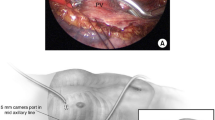Abstract
A previous study reported primary macroreentrant atrial tachycardia (AT) in the left atrium (LA), including the epicardial circuit on a left atrial anterior wall (LAAW) scar, without any prior cardiac intervention (Miyazawa et al. in J Cardiovasc Electrophysiol 2019; 30: 263-264). However, determining the target for terminating macroreentrant ATs is challenging. The mapping revealed a centrifugal pattern but did not fully elucidate the AT circuit. The reentrant mechanism of these ATs was confirmed using entrainment pacing. The earliest excitation site (EES) was traditionally selected as the ablation site, typically located in healthy tissue. However, our two cases provide new insights into AT termination, including the epicardial bridge across the endocardial LAAW scar, using minimum ablation points, without the need to ablate the healthy EES.


Similar content being viewed by others
References
Baskovski E, Altin AT, Akyurek O, Kuru B, Korkmaz K, Ersoy İ, Kozluca V, Akbulut IM, Tutar E. Electrophysiological characteristics of epicardial atrial tachycardias and endocardial breakthrough site targeting for ablation: a single center experience. J Interv Card Electrophysiol. 2023. https://doi.org/10.1007/s10840-023-01513-z.
Yamabe H, Okumura K, Morihisa K, Koyama J, Kanazawa H, Hoshiyama T, Ogawa H. Demonstration of anatomical reentrant tachycardia circuit in verapamil-sensitive atrial tachycardia originating from the vicinity of the atrioventricular node. Heart Rhythm. 2012;9:1475–83.
Yamabe H, Kajiyama K, Soejima T, Fukami Y, Haraguchi K, Okonogi T, Hirai K, Fukuoka R, Orita Y, Umeji K, Koga H, Kawasaki T. Comparison of the catheter ablation outcome in patients between targeting the entrance and exit of the reentry circuit in verapamil-sensitive atrial tachycardia originating from the atrioventricular-node vicinity. Heart Vessel. 2021;36:1201–11.
Pashakhanloo F, Herzka DA, Ashikaga H, Mori S, Gai N, Bluemke DA, Trayanova NA, McVeigh ER. Myofiber architecture of the human atria as revealed by submillimeter diffusion tensor imaging. Circ Arrhythm Electrophysiol. 2016;9:e004133.
Sawhney N, Anousheh R, Chen W, Feld GK. Circumferential pulmonary vein ablation with additional linear ablation results in an increased incidence of left atrial flutter compared with segmental pulmonary vein isolation as an initial approach to ablation of paroxysmal atrial fibrillation. Circ Arrhythm Electrophysiol. 2010;3:243–8.
Wong KC, Paisey JR, Sopher M, Balasubramaniam R, Jones M, Qureshi N, Hayes CR, Ginks MR, Rajappan K, Bashir Y, Betts TR. No benefit of complex fractionated atrial electrogram ablation in addition to circumferential pulmonary vein ablation and linear ablation: benefit of complex ablation study. Circ Arrhythm Electrophysiol. 2015;8:1316–24.
Wang H, Xi S, Chen J, Gan T, Huang W, He B, Zhao L. Left atrial anterior wall scar-related atrial tachycardia in patients after catheter ablation or cardiac surgery: electrophysiological characteristics and ablation strategy. J Cardiovasc Dev Dis. 2022;9:249.
Author information
Authors and Affiliations
Contributions
Shota Tamura: drafting the article,
Kenji Shimeno: the conception and design of the study,
Yusuke Hayashi: revising it critically for important intellectual content,
Takahiko Naruko: revising it critically for important intellectual content,
Daiju Fukuda: final approval of the version to be submitted.
Corresponding author
Ethics declarations
Ethics approval and consent to participate
This retrospective article of case reports is not subject to informed consent by the participants..
Conflict of interest
The authors declare no conflict of interest.
Additional information
Publisher’s Note
Springer Nature remains neutral with regard to jurisdictional claims in published maps and institutional affiliations.
Supplementary information
Activation map with a Sparkle map in case 1 (MP4 2357 kb)
Activation map with a Ripple map in case 2 (MP4 4358 kb)

Supplementary Figure 1
Electrocardiogram before second procedure in case 1 (PNG 707 kb)

Supplementary Figure 2
Electrocardiogram before second procedure in case 2 (PNG 689 kb)
Rights and permissions
Springer Nature or its licensor (e.g. a society or other partner) holds exclusive rights to this article under a publishing agreement with the author(s) or other rightsholder(s); author self-archiving of the accepted manuscript version of this article is solely governed by the terms of such publishing agreement and applicable law.
About this article
Cite this article
Tamura, S., Shimeno, K., Hayashi, Y. et al. Effective ablation of atrial tachycardia with an epicardial circuit—insights from endocardial scars sites: a case study. J Interv Card Electrophysiol 67, 1–3 (2024). https://doi.org/10.1007/s10840-023-01687-6
Received:
Accepted:
Published:
Issue Date:
DOI: https://doi.org/10.1007/s10840-023-01687-6




